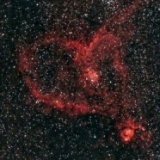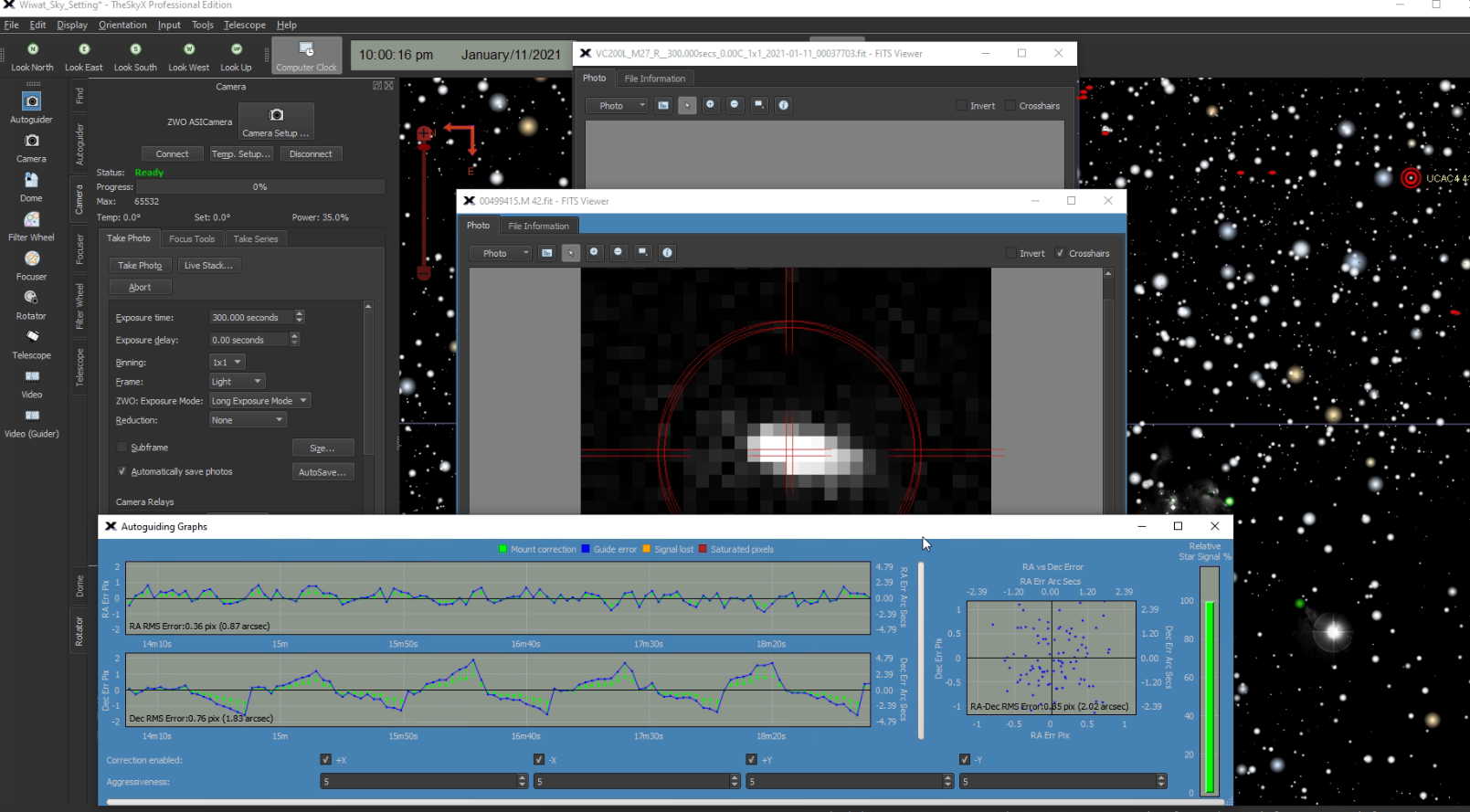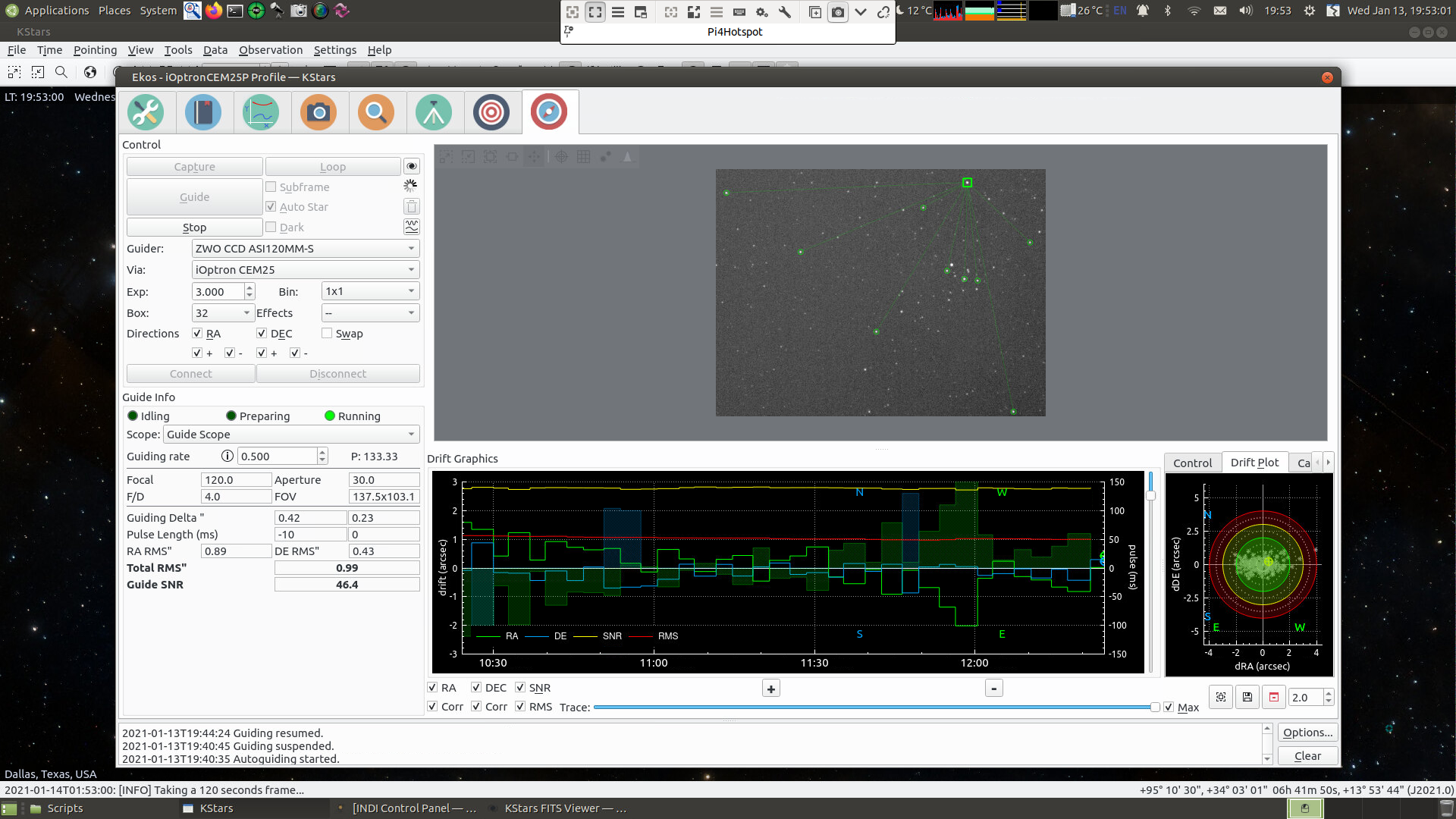INDI Library v2.0.7 is Released (01 Apr 2024)
Bi-monthly release with minor bug fixes and improvements
CEM25P users - DEC backlash problem
- Gonzothegreat
-

- Offline
- Moderator
-

- Posts: 2255
- Thank you received: 223
Replied by Gonzothegreat on topic CEM25P users - DEC backlash problem
Please Log in or Create an account to join the conversation.
Replied by anat on topic CEM25P users - DEC backlash problem
I have the same issue. How did you solve the problem? Thanks.
Please Log in or Create an account to join the conversation.
- Jose Corazon
-
 Topic Author
Topic Author
- Offline
- Supernova Explorer
-

- Posts: 1119
- Thank you received: 182
Replied by Jose Corazon on topic CEM25P users - DEC backlash problem
Nonetheless, this remains finicky. For instance, I can now get outstanding DEC guiding with an RMS of 0.5" early in the evening, only to see it fall apart and disintegrate to >1" after the meridian flip. That shows the mechanical limitations of the mount.
You will have to get a feel for how much tension the belt should have and whether the axle is running tight, but without excessive resistance, etc. A real problem IMO is that the DEC motor is drawing about 40% less power than the RA motor, which results in it losing steps whenever there is too much resistance.
Also, make sure that the mount is perfectly balance in DEC and that there is no cable drag. With those weak motor, you have to strive to eliminate any potential mechanical interference.
Hope that helps,
Jo
Please Log in or Create an account to join the conversation.
Replied by anat on topic CEM25P users - DEC backlash problem
Thank you for your input. Did DEC belt tensioning eliminate the sawtooth pattern in the DEC guiding graph?
Please Log in or Create an account to join the conversation.
Replied by anat on topic CEM25P users - DEC backlash problem
Please Log in or Create an account to join the conversation.
- Jose Corazon
-
 Topic Author
Topic Author
- Offline
- Supernova Explorer
-

- Posts: 1119
- Thank you received: 182
Replied by Jose Corazon on topic CEM25P users - DEC backlash problem
Frankly, from looking at the simple construction, I am amazed that the mount can perform as well as it does (most of the time now) for me.
Please Log in or Create an account to join the conversation.
- Jose Corazon
-
 Topic Author
Topic Author
- Offline
- Supernova Explorer
-

- Posts: 1119
- Thank you received: 182
Replied by Jose Corazon on topic CEM25P users - DEC backlash problem
Please Log in or Create an account to join the conversation.
Replied by Ron DeBry on topic CEM25P users - DEC backlash problem
Finally opened up the housing and the Dec belt was pretty slack. Tightened it - it seemed about 3mm of give. RA belt was already about like that, so I left it alone. At the same time I figured PHD2 out enough to run Guiding Assistant for the first time (so nothing to compare from before the first belt tweaking - my guess is it would have reported too much to compensate for). After the first tightening PHD2 reported 1450ms Dec backlash. It actually guided OK, but having read a CN thread where people had gotten theirs down to 3-400ms I got greedy and went back in and tightened the belt more. With very little play in the belt now, GA reported 2500ms backlash.
So - sounds like it is possible to have the belt too tight, correct?
Second question: Do we know exactly how the locking knob interacts in terms of backlash? I first backed it out enough for it to not stall at speed 9 (360 deg). At that point, it would still "hesitate" some when watching a star at speed 3, so I backed it out another 90 degrees and that was sorted. But I suspect speed 3 is still a lot faster than what the guiding pulses use, correct? So I should back it out a bit more. But is it best to just go "plenty further out" however that is defined
Thanks for any pointers - I feel that I am close to getting good consistently guiding - I hope.
Please Log in or Create an account to join the conversation.
- Jose Corazon
-
 Topic Author
Topic Author
- Offline
- Supernova Explorer
-

- Posts: 1119
- Thank you received: 182
Replied by Jose Corazon on topic CEM25P users - DEC backlash problem
The main drawback of the DEC stepper motor is its current limit, which is about 2/3 of the RA motor (for my CEM25P). That means that the motor is prone to losing steps if there is ANY excessive drag.
As you found out, overtightening the tension screw can induce such drag.
As for sufficient pressure on the worm gear: I now wiggle the mount in DEC while tightening the tension screw. Once I can no longer feel a discernible movement, that's when I tighten another half turn, then stop. I found that to work best in my hands. Depending on where the telescope is pointing, i.e. how much potential torque there is on DEC, I can now get the DEC RMS down to <0.5 on a good day.
All that being said, I think we have to be realistic and accept that a low end mount like the CEM25P is not optimal for telescopes with a focal length of >500 mm. I am using it with a WhiteCat (250mm focal length) and for that it is perfect.
Jo
PS: Yes, I think you can overtighten the belt. Also, make sure the belt is aligned with the gears and does not run in an oblique path over the gears.
Please Log in or Create an account to join the conversation.
Replied by Ron DeBry on topic CEM25P users - DEC backlash problem
But then I moved to the west, pointing at M45. Ran GA and got >21000ms. Tried various settings for the tension knob, but always >19000ms. So it looks like adjusting the dec mesh is my weekend project.
I think I have a decent idea what is supposed to happen. I will check the hinge tightness. But in terms of the mesh, it is basically: loosen the 3 hex screws along the hinge, lower the worm onto the ring gear. It should seat itself and in doing so move the hinge into the correct position. Then you just tighten the 3 hex screws to hold it there. I understand the part about moving the gears to find where it still binds and then re-doing the mesh there. Guess I'm just looking for confirmation that my view of how "adjusting the mesh" works is correct.
Did you watch the Paul Chasse ZEQ25 videos? I'm not sure what it is about putting a spacer between the tension screw and the hinge during the re-mesh accomplishes. My best guess is that it evens out the pressure along the hinge a bit. Did you do anything like that?
Please Log in or Create an account to join the conversation.
- Jose Corazon
-
 Topic Author
Topic Author
- Offline
- Supernova Explorer
-

- Posts: 1119
- Thank you received: 182
Replied by Jose Corazon on topic CEM25P users - DEC backlash problem
Thanks for this report! I have seen the same thing repeatedly, guiding accuracy on the same target shifting dramatically after the meridian flip. It can only be mechanical. I have not done much imaging over the last two months for personal reasons, but on the two occasions I did I thought I had that problem pretty much gotten down to a minimum.
I did not know about the ZEQ25 videos. Can you post the link?
Best, Jo
Please Log in or Create an account to join the conversation.
Replied by Ron DeBry on topic CEM25P users - DEC backlash problem
I don't think Paul is currently active on CN (astronewb), or I'd ask him why he says the metal ruler is the secret weapon in getting the perfect mesh. I guess the same principles apply to the CEM25P and ZEQ25. The upgrade kit included a new motor and a new worm gear, but not anything different with the hinge and worm housing.
Please Log in or Create an account to join the conversation.



